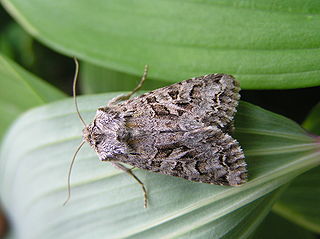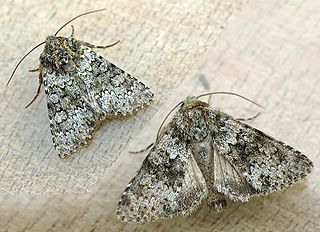
Welwitschia is a monotypic gymnosperm genus, comprising solely the distinctive Welwitschia mirabilis. The plant is commonly known simply as welwitschia in English, but the name tree tumbo is also used. It is called kharos or khurub in Nama, tweeblaarkanniedood in Afrikaans, nyanka in Damara, and onyanga in Herero. Welwitschia is the only living genus of the family Welwitschiaceae and order Welwitschiales, in the division Gnetophyta. Informal sources commonly refer to the plant as a "living fossil". Welwitschia mirabilis is endemic to the Namib desert within Namibia and Angola.
The name Aetheria may refer to:
Mirabilis is a Latin adjective meaning "amazing, wondrous, remarkable", and is used to refer to:

Mirabilis is a genus of plants in the family Nyctaginaceae known as the four-o'clocks or umbrellaworts. The best known species may be Mirabilis jalapa, the plant most commonly called four o'clock.

Proteus is a genus of Gram-negative Proteobacteria. Proteus bacilli are widely distributed in nature as saprophytes, being found in decomposing animal matter, sewage, manure soil, the mammalian intestine, and human and animal feces. They are opportunistic pathogens, commonly responsible for urinary and septic infections, often nosocomial.

Proteus mirabilis is a Gram-negative, facultatively anaerobic, rod-shaped bacterium. It shows swarming motility and urease activity. P. mirabilis causes 90% of all Proteus infections in humans. It is widely distributed in soil and water.

Nepenthes mirabilis, or the common swamp pitcher-plant, is a carnivorous plant species. By far the most widespread of all Nepenthes, its range covers continental Southeast Asia and all major islands of the Malay Archipelago, stretching from China in the north to Australia in the south. The species exhibits great variability throughout its range. One of the more notable varieties, N. mirabilis var. echinostoma, is endemic to Brunei and Sarawak and possesses an extremely wide peristome.
Diclonius is a genus of dinosaur from the Late Cretaceous. It was a hadrosaur based solely on teeth. Its fossils were found in the Judith River Formation of Montana, northern US. The name is in reference to the method of tooth replacement, in which newly erupting replacement teeth could be in functional use at the same time as older, more worn teeth. Thus, the number of "sprouting" teeth was doubled in comparison to Monoclonius, which used only one set of teeth at a time and which Cope named in the same paper.

The Hadenini are a mid-sized tribe of moths in the Hadeninae subfamily. As numerous hadenine genera have not yet been assigned to a tribe, the genus list is preliminary.

Hemiphlebia mirabilis, commonly known as the ancient greenling, is a species of damselfly in the family Hemiphlebiidae. It is very small with a long, metallic-green body and clear wings. It is endemic to south-eastern Australia. Its natural swamp habitat is threatened by habitat loss.

Hecatera dysodea, the small ranunculus, is a moth of the family Noctuidae. It is found in Europe, primarily in Central Europe and Southern Europe and from Algeria and Morocco up to Turkestan. It is an introduced species in North America, where it was first found in Utah in 1998 and Oregon in 2005.
Epipsammia was a genus of moths of the family Noctuidae. It is now considered a synonym of Hecatera. It consisted of the species Epipsammia deserticola, which has been renamed to Hecatera deserticola.

Hecatera is a moth genus in the family Noctuidae.
Pseudathetis was a genus of moths of the family Noctuidae. It is now considered a synonym of Hecatera. It consisted of the species Pseudophia fixseni, which is now renamed to Hecatera fixseni.
Sartha was a genus of moths of the family Noctuidae. It is now considered a synonym of Hecatera.

Aureoboletus mirabilis, commonly known as the admirable bolete, the bragger's bolete, and the velvet top, is an edible species of fungus in the Boletaceae mushroom family. The fruit body has several characteristics with which it may be identified: a dark reddish-brown cap; yellow to greenish-yellow pores on the undersurface of the cap; and a reddish-brown stem with long narrow reticulations. Aureoboletus mirabilis is found in coniferous forests along the Pacific Coast of North America, and in Asia. Unusual for boletes, A. mirabilis sometimes appears to fruit on the wood or woody debris of Hemlock, suggesting a saprobic lifestyle. Despite occasional appearances to the contrary, Aureoboletus mirabilis is mycorrhizal, and forms close mutualistic associations with hemlock roots.
H. intermedia may refer to:

Araucaria mirabilis is an extinct species of coniferous tree from Patagonia, Argentina. It belongs to the section Bunya of the genus Araucaria.
The Syncystidae are a family of parasitic alveolates in the phylum Apicomplexa. Species in this family infect insects (Aeshnidae).
Syncystis is a genus of parasitic alveolates in the phylum Apicomplexa.












